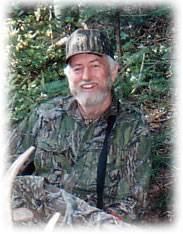Questions & Answers
Why do concave Broadheads cut bigger holes than straight blade or convex shaped heads?
Answered by Dr Ron Sanders
- Summary... As we begin this brief tutorial, remember that high-speed photography clearly shows that a broadhead wound is produced by the front 15% of the broadhead cutting edge and the last 10%.
- Remember, the middle 75% of the cutting edge doesn't contribute to the cut because the skin is already stretching. Because of the markedly-wider wings of concave broadheads, compared to the moderate tail width of most broadheads, the wound is much larger. Concave broadheads regularly produce wound channels at least 50% wider than the broadhead's width, and as much as 200% the width, depending on impact angle.
- When the tip contacts skin, a hole is cut and natural skin elasticity stretches the hole wider than the tip, relaxing the skin. Next, the wings of the concave cutting edge slice through the already-relaxed skin which is offering much less resistance, producing an extremely large wound channel.
- A second , and HUGE advantage of concave cutting-edge broadheads is what we refer to as "dig-in". An extremely angling shot can produce a long cut until the concave broadhead wing "digs in" and directs the arrow internally rather than glancing out.
Ron Sanders MD
Save My Life Card, Inc

Why should I select a concave design?
- Superior flight characteristics stemming from
less surface area which allows any width concave
head to fly better than narrower heads.
- Creates a large wound. The hooking effect of
the concave edge or shape doesn't allow blood vessels
or tissue to roll around and not be cut.
- Takes less force to create a wider cut because
there is little steel in the hook performing in
tissue much like a cheese cutter does in cheese.
- Allows little chance for a glance off on severe
angle hits. Even if the hook touches first, a drag
is created keeping the arrow in contact until it
bites in.
What will help me get better arrow flight?
- Determine the shafting and spine that shoots
best from your bow and fine tune
- 5" helical fletching quickly stabilizes
arrow flight if needed or desired.
Any Tips on Shooting?
- First and foremost, your arrow must be spined
properly for your bow weight. This can be easily
done by checking the arrow charts to match your
bows weight.
- To get your broadheads to shoot the same
group as your field points we suggest the use
of helical fletching, 4” fletching is acceptable,
but 5” will stabilize your arrow in flight much
faster and give you better overall flight. What
most people don’t realize is that the faster
your arrow stabilizes the more room you have
for error on your part. In a nutshell, 5” helical
fletching is much more forgiving, particularly
when you make shooting errors such as hand-torque.
In most situations, especially in a tree-stand,
we need all the help we can get shooting in
awkward positions.
- The recent development of the “drop away”
arrow rest is probably the best thing to happen
to fixed blade broadheads. Perfect arrow flight
can now be achieved at high speeds using ultra
light carbon arrows. We cannot endorse any individual
manufacturer, but we have tried several different
ones and they all seem to give the same flight
characteristics. We do recommend that you look
for a simplistic design without too many adjustments
and be sure to take note if it has enough drop
to fully clear your fletching.
